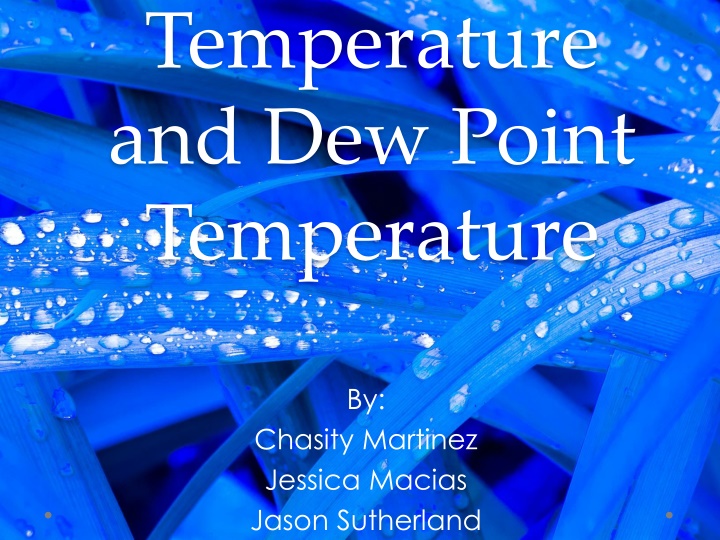
Temperature Sensors and Calibration Techniques
Learn about temperature and dew point sensors, how they work, calibration processes, lapse rates, and interpreting data for optimized efficiency. Explore improvements for future experiments and the functionality of Teensy sensors in scientific applications.
Download Presentation

Please find below an Image/Link to download the presentation.
The content on the website is provided AS IS for your information and personal use only. It may not be sold, licensed, or shared on other websites without obtaining consent from the author. If you encounter any issues during the download, it is possible that the publisher has removed the file from their server.
You are allowed to download the files provided on this website for personal or commercial use, subject to the condition that they are used lawfully. All files are the property of their respective owners.
The content on the website is provided AS IS for your information and personal use only. It may not be sold, licensed, or shared on other websites without obtaining consent from the author.
E N D
Presentation Transcript
Temperature and Dew Point Temperature By: Chasity Martinez Jessica Macias Jason Sutherland
Outline Description of temperature sensor and how it works Time series of temperature and dew point temperature Calibration of temperature data Boundary layer Lapse rate Discussion and interpretation of data Efficiency of Teensy sensors Improvements for future experiments
How the Temperature and Humidity Sensors Works Provides fully digital output Pin 1: serial clock Pin 2: source voltage Pin 3: ground Pin 4: serial data (transfers data in and out of the sensor) Long term exposures to humidity can offset RH signal Self-heating occurs if measurement frequency is too high.
Sonic Anemometer c= RT c=speed of sound (m/s) =?? ??=???????? ???? ?? ??? ??? ?? ???????? ???????? R=ideal gas constant=?.??? ? air) T=sonic temperature ???????? ???? ?? ??? ??? ?? ???????? ??????=1.4 ?? ?*M (molecular weight of dry By obtaining speed of sound, temperature can be calculated by: T=??? ?
Time Series of Temperature
Time Series of Dew Point Temperature
Calibration of Temperature Teensy 1 (Balloon), Teensy 3 and Teensy 4 showed similarities based on time series graphs. Averaged values for each Teensy card in time period of 17:45 UTC to 18:45 UTC. To calculate ideal temperature, we used the values from the previous step and then averaged those values.
Calibration of Temperature To calculate the calibration factor, the ideal temperature was divided by each individual Teensy card average. For each Teensy card, the calibration factor was multiplied for all temperature values and then graphed.
Calibrated Temperature Graph
Boundary Layer The layer most affected by the earth s surface. (influences temperature, moisture, wind velocity) It is said to be unstable when the surface is warmer than the air (sunny day with light winds) It is stable when the surface is colder than the air (clear night) Temperature decreases at adiabatic lapse rate when air rises and expands.
Lapse Rate To calculate the lapse rate, the following equation was used: (z)=???????? ???????? (provided by Pressure group) , where z=height ?
Discussion and Interpretation of Data Dew point temperature did not need to be calibrated due to values from all four sensors showing similarities Dew point temperatures and air temperatures were far apart throughout the day Air temperature needed to be calibrated because there were irregularities with Teensy 2. To form calibration, we used Teensy cards 1, 3, and 4 because they showed most similarities with one another. Solar heating had an effect on temperature sensors 1, 3, and 4
The Efficiency of Temperature Sensors Location and placement of sensors Methods of shielding -The only shield some of the sensors had were a piece a paper over them. Lack of ventilation and too many measurements causes self heating (mechanism that produces a warmer condition).
Improvements Use the same shielding mechanism for each Teensy card Use a new and improved shielding mechanism to allow ventilation and prevent heating of sensor. - something better than just a piece of paper wrapped around it.
